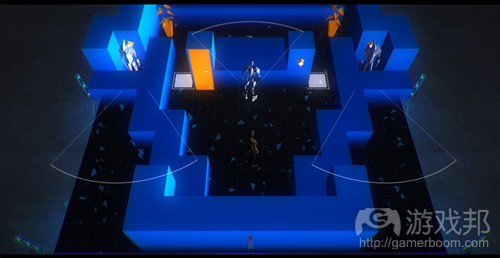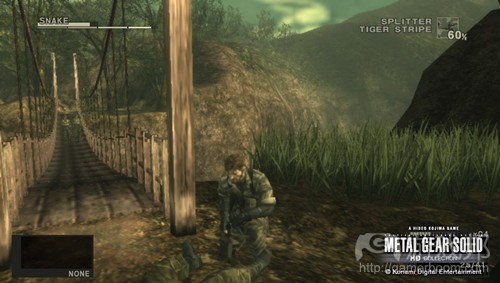探讨设计一款优秀潜行游戏的方法
作者:Kevin Wong
在过去一年里我玩了许多潜行游戏,并将在明年致力于两款这样的游戏。我想要花些时间去研究它们,并识别那些让它们显得有趣的根本线程和循环。
至少对于我来说,潜行游戏的核心乐趣便是穿越广阔的空间的有趣的移动。对于潜行游戏系统的精通将提供给玩家全新且富有创造性的方法去应对关卡。潜行游戏的核心便是两种认知状态间的简单游戏循环。这些状态是:
潜行:玩家在未被察觉的状态下通过关卡的目标,同时想办法不被敌人发现。
逃离:玩家被敌人发现,必须在触发一个事件而回到游戏中的潜行状态前想办法存活下来。
在这两种状态下玩家需要使用同样的动作,但却需要根据他们当前的状态而基于不同方式去使用这些动作。这一核心的潜行–逃离循环是由以下能够呈现更高程度的意外险的子系统和性能所支撑着。这些子系统和性能分别是:
Grunts的多样性
过强的玩家角色
遍布特权的关卡设计
GRUNTS
每款战斗导向型游戏都有能够抑制玩家前进且需要玩家想办法与之抗衡的敌人。潜行游戏不同于其它行动游戏,因为它们的敌人将会呈现出与众不同的挑战类型。通常情况下,行动游戏中的独立敌人只会呈现一些威胁,并且游戏中的遭遇战也是为了使用综合敌人类型去推动特定的战斗类型。而潜行游戏中的敌人却带有完全不同的目的,他们将沿着关卡创造谜题般的挑战。
鉴于传统的敌人使用的是一个“暴力循环”系统,守卫一般拥有瞄准线,任何区域只要处于守卫的瞄准线内,其安全便会受到威胁,如果玩家进入了这一瞄准线,他们便算进入了“逃离”状态。这一瞄准线并非由硬编码所创造的,而在环境中的对象所创造的遮盖物能够让安全领域存在于这一瞄准线中。或者玩家也能够使用伪装而混在这一环境中,从而导致守卫的瞄准范围变得较小。
通常情况下守卫拥有3种AI状态,即会沿着更大的游戏状态发生改变,但每个守卫实例的个体层面则是基于玩家的行动。这些状态分别是:
空闲:在预先设定好的道路上巡逻。(只呈现出潜行状态)
搜索:敌人未察觉到玩家,调查了声音或分散他们注意力的来源,转变瞄准线去对准一个特定区域。(潜行和逃离状态)
警戒:敌人积极追赶并捕获玩家。(只呈现出逃离状态)
迫使敌人从空闲状态变成搜索状态是玩家需要精通的最重要的技能之一。通过在特定区域中设置一个喧闹的人,玩家便可以误导守卫将瞄准线朝向一个不同区域,从而让自己有机会不被发现地穿越过去。敌人AI必须是能让玩家预测到的,如此他们才能利用并控制这些属性。
玩家可以选择在潜行的状态下与这些敌人相抗衡,使用像无声枪,手榴弹和绊网等道具有效地击倒远处的敌人,或者悄悄靠近他们去执行秘密的拆卸行动。消灭守卫将能够减少某一区域的巡逻数量,从而确保玩家能够更安全地穿越一个关卡。与这些守卫展开战斗是一种次优的策略,和平地游戏才是技能型方法。
玩家可能会在逃离状态下使用战斗机制,即守卫呼叫增援部队去对抗玩家时。像冲锋枪等道具都是玩家想要回到潜行状态时可能使用的方法。像《蝙蝠侠》等游戏也允许玩家使用这种方法打败所有的敌人,让玩家能够选择完全放弃潜行。
玩家优势
尽管潜行游戏的核心叙述是在面对无助感时取得成功,即描述“受压迫者”的内容,但是玩家仍然具有一些优势能够在战争以外的情境下战胜敌人。以下是我在研究过的游戏中所遇到的玩家优势:
移动性
隐藏术
情报
小工具
在像《蝙蝠侠》和《耻辱》等游戏中,玩家便能够拥有更强的移动性,并能够靠近守卫所触及不到的一些地方。抓住椽木或滴水嘴都能让玩家在各自的游戏中获得更多优势。这些移动优势能够鼓励玩家在发动攻击后快速逃离现场。你可能会注意到AI守卫很少会匍匐行进,所以任何时候当你隐藏在桌子底下或通风孔内部时,你便能够有效地利用移动优势了。
很多时候,玩家的角色具有进入许多不同的状态而避免被守卫发现的能力。这与《最后生还者》中的蹲伏能力以及《合金装备3》中多彩的环境生态系统与伪装术一样简单。玩家角色的这些改变都能够转移守卫的视线,让他们能够更轻松地穿越关卡。
也许玩家获得的最重要的优势应该是情报。简单地说,情报优势能够提供给玩家当前游戏创造的某种程度的信息,告知他们敌人的位置,拥有哪些状态,生命值以及行进路线等待。这让玩家能够制定策略绕着适当的环境移动,并寻找最省力的路径。像《孤岛惊魂》的双筒望远镜,《蝙蝠侠》的Detective Vision以及《合金装备》的SOLITION雷达便都呈现了这一优势。
在提到小工具这一元素时我有点犹豫,因为很多时候小工具总是用于帮助前三种优势。像《分裂细胞》的snakecam等道具能够提供情报,《Snake》的纸板盒具有隐藏优势。然而不管是道具还是工具都是这类型游戏的核心元素,而通过它们的结合去搜索紧急使用方法则是这类型优势所呈现出的核心乐趣。
沙盒关卡
我想到目前为止我们已经创造了潜行游戏的核心目标,即穿越而不是战斗。穿越空间的战术移动与这些游戏可能使用的不同潜行方法相联系着,比起在一系列战争中幸存下来,完成一个关卡的感受更像是解决一道空间谜题。
为了达到这种程度,关卡的设计必须是围绕着守卫的移动以及玩家穿越空间的行动。它们必须让守卫拥有足够的空间对关卡的一大部分造成威胁,同时还需要让玩家能够利用策略在空间中穿行着。我并不是一个优秀的关卡设计师能够识别潜在的线程而创造出优秀的潜行环境,但是我却能够识别一些常见的特征。
潜行游戏关卡拥有许多路径,这让玩家能够更有自信地想出通过关卡的方法。《合金装备5》的Camp Omega便是我所玩过的这类型设计中拥有最佳环境的一款游戏。
就像我之前提到的,掩盖物能够阻隔敌人的视线,为玩家创造一个安全的空间。掩盖物的分布以及因为守卫的移动而导致的局限性为玩家的进出创造了一个重要的节奏,他们将在此移动并消灭敌人而到达目标。我认为《最后生还者》便是一款有效地做到这一点的游戏,它谨慎地设置了掩盖物从而向玩家角色传达了这种道具所具有的易损性,甚至是在精通了AI草种和移动模式之后。
最后,潜行游戏关卡倾向于只突出玩家能够访问的区域。爬行空隙,排水管道,椽木以及通风井都为玩家躲避守卫提供了战术优势。《耻辱》便通过禁止AI守卫垂直移动,并允许玩家将任何凸起且垂直的领域当前安全空间而做到了这一点。
我是忍者
所以让我们回到潜行和逃离的核心循环中,这两种状态间的移动便是优秀的潜行游戏的核心。糟糕的潜行游戏总是不能有效地设计逃离部分,未能提供给玩家任何选择去补偿他们的失败并将游戏状态带回潜行状态,所以潜行游戏的设计师应该考虑在逃离阶段提供给玩家情境支持而帮助他们解决问题。不断让玩家被察觉到便是一种糟糕的设计。设计师必须想出一种避免失败且让玩家能够在两种状态间移动的方法。
(本文为游戏邦/gamerboom.com编译,拒绝任何不保留版权的转载,如需转载请联系:游戏邦)
Stealth Game Design
by Kevin Wong
I’ve been playing a lot of stealth games over the last year, and will be working on two moving onto the next year. I’d like to take a moment to take a close look at them and identify some underlying threads and loops that make them fun.
At least for me, the core joy of the stealth game is the playful movement through a wide possibility space for emergent player expression. Mastery of stealth game systems bestows new, creative ways for players to solve levels. At the heart of the stealth game is a simple game loop between two cognitive states. These states are:
Sneaking: Player is undetected and is traversing to the level’s goal, while avoiding enemy detection.
Fleeing: Player is detected by the enemy and must survive until she triggers an event that returns the game to the Sneaking state.
Players have access to the same verbs in both of these states, but are asked to use these verbs in different ways depending on their current state. This core, Sneaking-Fleeing loop is supported by a number of subsystems and properties that allow for that high degree of emergence. These subsystems and properties are:
The Multiplicity of Grunts
Overpowered Player Character
Level Design that privileges traversal.
GRUNTS
Every combat-oriented game has enemies that inhibit player progression and must be dealt with violently or otherwise. Stealth games are distinct from other action games in that their enemies pose a very different type of challenge than their counterparts. Typically, individual enemies in action games pose little threat, and encounters are designed to use a combination of enemy types to encourage a certain style of combat. Enemies in stealth games fulfill a very different purpose, and operate alongside the levels that they populate to create puzzlelike traversal challenges.
Whereas typical enemies use an “aggro-circle” system, guards have lines of sight, any area falling within a guard’s line of sight is threatened, and if the player enters this line of sight, they enter the “fleeing” state. This line of sight isn’t hardcoded, and cover created by objects in the environment alters this line of sight, allowing for safe-spaces to exist inside the line. Alternatively, players can use camouflage to blend in with their environment, making each guard’s vision-line much smaller.
Guards typically have three AI-states, which operate alongside the larger gamestate, but on an individual level for each instance of the guard based on player-action. These states are:
Idle: Unaware, patrolling predetermined paths. (Sneaking state only)
Searching: Enemy unaware of player, investigating source of sound or distraction, altering line of sight to affect a certain area. (Sneaking & Fleeing States)
Alert: Enemy actively hunting down player. (Fleeing state only)
Forcing an enemy from the idle state to the searching state is one of the most important skills that players can master. By throwing a noisemaker at a certain area, players can mislead a guard towards a different part of the level, altering their line of sight and permitting the player to pass through an area undetected. Enemy AI must be predictable enough for players to exploit and manipulate these properties.
Players may choose to fight these enemies while in the Sneaking state, using items like silent guns, grenades, and tripwires to advantageously defeat enemies from afar, or sneak up close to preform a stealth takedown. Eliminating guards, lethally or nonlethally, reduces the total number of lines-of-sight patrolling an area, making it overall safer to traverse a level. Violent confrontation of these guards is typically a less-optimal strategy, and pacifistic play is usually indicative of very skilled play.
Combat mechanics may also be employed during the Fleeing phase, where guards call in reinforcements to deal with the player. Loud, lethal options like assault rifles are available to players to deal with pursuing guards as an interstitial step to seeking a way to return to the Sneaking state. Some games like Batman may allow the player to violently defeat all enemies in a level this way, allowing players to choose to forgo stealth altogether.
PLAYER ADVANTAGES
While the core narrative of the stealth game is one of triumph in the face of disempowerment, very much one depicting an “underdog”, players still are afforded a number of advantages that allow them to overcome enemies outside of pure combat. I’ve identified four present in the games that I’ve studied.
Mobility
Hiding
Intelligence
Gadgets
In games like Batman and Dishonored, players are given abilities that afford greater mobility, permitting access to parts of the level that guards cannot reach. Blinking onto the rafters or grappling up onto a gargoyle grants players a vertical advantage core to many of the more advanced strategies to their respective games. These advantages of mobility encourage players to make quick escapes and frantic, hit-and-run attacks. You may also notice that AI guards can very rarely crawl, and any time you’ve hid under a table or inside a vent, you’ve been exploiting an advantage of mobility.
Oftentimes, the player’s avatar has the ability to enter a number of different states that may allow him to be less detectable by guards. This can be as simple as the crouch ability from The Last of Us, to Metal Gear Solid 3’s colorful ecosystem of environments and camouflage fatigues. These changes to the player’s avatar reduce or alter the size and shape of the guard’s cones of vision, allowing for easier traversal through the environment.
Perhaps the most important advantage that the player can be conferred with is the advantage of intelligence. Simply put, the advantage of intelligence confers the player with a degree of knowledge over the current gamestate, revealing enemy positions, equipment, health, and paths. This allows players to strategically plan their movement around the environment, seeking out the path of least resistance. This advantage may manifest in systems like Farcry’s binoculars, Batman’s Detective Vision, or Metal Gear Solid’s SOLITION radar.
I put “gadgets” here with some hesitation because oftentimes, gadgets serve to facilitate the previous three types of advantages. Items like Splinter Cell’s snakecam afford intelligence, and Snake’s cardboard box confers a hiding advantage. Nonetheless, items and tools are a central aspect of these kinds of games, and searching for emergent uses from their combination is a central part of that joy of expression inherent to the genre.
SANDBOX LEVELS
I believe that by now we have established that the core goal of the stealth game is traversal rather than combat. Tactical movement through space ties the different approaches to stealth that these games may deploy, and completing a level feels more like solving a spatial puzzle than surviving a series of encounters.
To that extent, levels must be designed around the movement of guards and players through space. They must permit the guards enough space to threaten a significant portion of the level, as well as enforce deliberate and strategic movement through space on terms of the player. I am not a good enough level designer to identify the underlying threads that make good stealth environments, but I can identify a few common characteristics.
Stealth game levels have a multiplicity of paths, allowing for players to feel a degree of authorship over their particular methods of solving levels. Metal Gear Solid 5’s Camp Omega is one of the best environments I’ve ever played in for this kind of design, and its opening minutes feature no more than four means of entering the base.
Cover, as I have stated before, cuts off enemy line-of-sight, creating safe spaces for players to stay in. The interspersal of cover, and its limited usefulness as guards move around it, creates an important rhythm as players dart in and out of it as they move to eliminate enemies and reach their goal. One game that I believe achieves in this regard is The Last of Us, which very deliberately distributes its cover to convey a sense of vulnerability for the player character, even after mastering AI manipulation and movement patterns.
Finally, stealth game levels tend to feature areas that only the player can access. Crawlspaces, rafters, and ventilation shafts confer tactical advantages that guards lack. Dishonored did this well by prohibiting vertical movement for its AI guards, allowing for any raised, vertical area to be a potential safe-space as players blinked towards their goals, which were typically positioned to demand horizontal traversal.
I’M A NINJA
So that takes us back to our core loop of sneaking and fleeing, the movement between these two states is core to good stealth games. Weak stealth games tend to have poorly designed fleeing segments, leaving players without any options to compensate for their failures and effectively bring the gamestate back into the sneaking state, so designers of stealth games should strongly consider the affordances players are granted to solve problems in the fleeing stage. Instantly failing the player for being detected isn’t good design. There must be a way to absolve failure and move between the two states in the loop.
I write this moving out of a year of closely studying stealth games. I’m a huge Metal Gear fan and played a lot of hide and seek in my youth, so unqualified as I may be, I think I can make some general statements on what makes good stealth games. More importantly, I’m believe this knowledge would be fundamental to me as I move onto my next two projects, which are both stealth games.(source:gamasutra)
上一篇:如何分辨游戏设计中的错误选择
下一篇:阐述数据导向型游戏引擎设计的概念









































 闽公网安备35020302001549号
闽公网安备35020302001549号